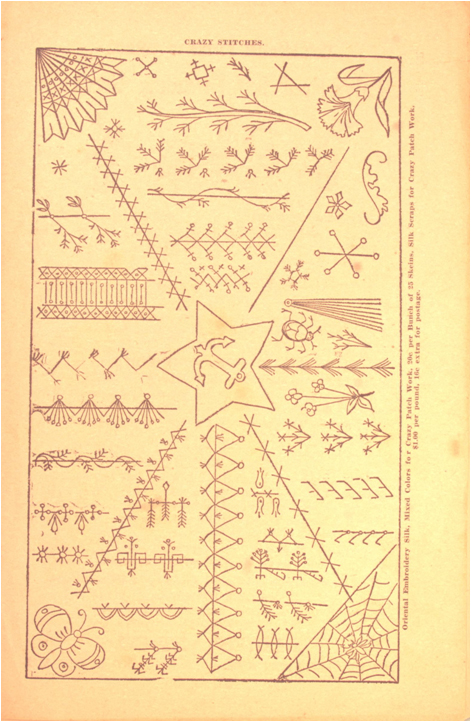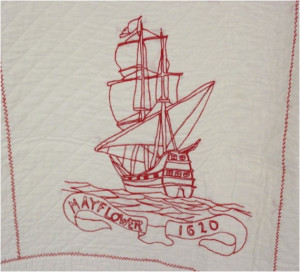Over 180 different quilting patterns were offered for sale as well as more than 1,000 perforated patterns for redwork or embroidery. The perforated patterns could be used on quilt blocks, clothing, pillows, and linens. The mainstay of the Ladies Art Company’s business, though, was selling quilt block patterns. Several catalogs were produced through the years, including their specialty catalogs containing the quilt kit patterns and the quilting patterns.
As early as June, 1892, Ladies Art Company offered a sheet of crazy stitches when you  ordered their “SILK, SATIN and PLUSH REMNANTS for Crazy Patch.” (4) Later, this page of stitches was incorporated into the early catalogs of Diagrams of Sofa and Pin Cushion Patterns.
ordered their “SILK, SATIN and PLUSH REMNANTS for Crazy Patch.” (4) Later, this page of stitches was incorporated into the early catalogs of Diagrams of Sofa and Pin Cushion Patterns.
Several crazy stitch patterns on this free handout from Ladies Art Company appear almost exactly the same as the patterns published by The Brainerd & Armstrong Co., c. 1885. (1)
Another set of crazy stitches was included in the 1922 over-sized catalog published by Ladies Art Company.
J.F. Ingall’s, The M.J. Cunning Co., Briggs, Bentley’s Art Needlework and Webber’s were well known for selling Perforated Stamping Patterns for Fancy Work.
 Stamping wax and stamping powder were sold to apply perforated patterns. Some instructions required a hot iron to transfer the patterns (although the author hasn’t found any references for use of a hot iron in her Ladies Art Company ephemera). Linens were also sold pre-stamped, or already finished.
Stamping wax and stamping powder were sold to apply perforated patterns. Some instructions required a hot iron to transfer the patterns (although the author hasn’t found any references for use of a hot iron in her Ladies Art Company ephemera). Linens were also sold pre-stamped, or already finished.
Sometimes these patterns were rewards for obtaining new magazine subscribers, advertisements to earn money at home, and as new decorating ideas for the house. “LADIES paid $10.00 per thousand making little lace wheels at home. Easy work. Prompt pay. No experience required. Send stamped envelope for sample and full particulars to ART NEEDLEWORK CO., 108 Worth St., N.Y. City.”(2)
The instructions for stamping embroidery or perforated patterns were written as follows:
“Stamping wax is used to transfer designs for embroidery work or work where the outline is entirely covered. To stamp, place the pattern on the material with the smooth side up and secure so that it will not move. Take a soft cloth or poncet, moisten with benzene or gasoline, rub over the wax, and then over the pattern; carefully remove the pattern, and the design will be clearly stamped on the material. Stamping wax is made in black, white and blue, put up in cakes. Price, 25c.” (2) To rid your fabric of the gasoline smell, you were to hang the finished project on the clothesline and air it out for a couple of days.
Below: Perforated pattern no. 5122, 13 x 14.5, 25 cts. Mayflower 1620 first shown in 11th Rev. Edition.


“When an outline/stem stitch was worked with silk threads on delicate fabrics, the fine line effect looked like — and was known as — etching. However, the terms outline and etching sometimes appeared interchangeably, regardless of the materials used. In the teens and twenties of the twentieth century, Ladies Art Company advertised the same designs on stamped linen as “Stamped Outline Embroidery Blocks For Nursery Quilts” and also as “Designs for Etched QuiltBlocks.”(3)
Click here to see the St. Louis Fancy Work Catalog, circa 1915, of wholesale patterns displaying several penny doylie patterns for sale.
(1)McMorris, Penny. Crazy Quilts. New York: E.P. Dutton, 1984, pg. 32.
(2)- The Modern Priscilla, Boston, Mass. October 1904, pg 20.
(3) Catalog of Quilts and Quilting, Ladies Art Company
(4)Harding, Deborah Red & White: American Redwork Quilts. New York: Rizzoli International Publications, 2000, pg.40.
(5) The Ladies’ World, New York: S.H. Moore & Co., June 1892, pg 17.
Copyright 2014– Connie Chunn
